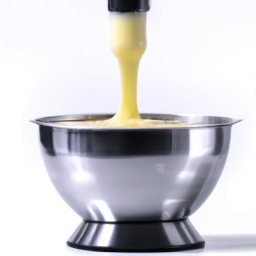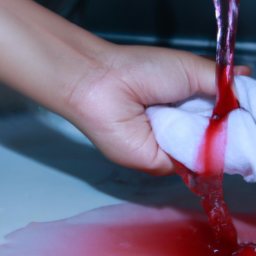Baking has always been a passion of mine, but avoiding dairy can make it challenging to replace certain ingredients like buttermilk. However, I’ve discovered that making buttermilk using almond milk and lemon juice is not only easy, but it also yields great results.
In this article, I will share with you the step-by-step process of making buttermilk with almond milk and lemon juice, as well as some tips and tricks to ensure success every time.
Using almond milk and lemon juice to make buttermilk not only provides a dairy-free alternative, but it also offers numerous health benefits. Almond milk is low in calories and fat, making it a great choice for those watching their weight. It is also rich in vitamin E, which is essential for maintaining healthy skin and hair.
Lemon juice, on the other hand, is packed with vitamin C, which helps boost immunity and fight off infections. Together, these two ingredients create a delicious and nutritious buttermilk substitute that can be used in a variety of recipes.
Key Takeaways
- Almond milk and lemon juice can be used to make a dairy-free, vegan-friendly buttermilk substitute.
- The ratio of almond milk to lemon juice needs to be precise and the mixture should sit for 5-10 minutes to thicken.
- Homemade buttermilk can be used in a variety of recipes and is a healthier alternative to traditional buttermilk.
- Other alternatives to buttermilk include soy milk, coconut milk, yogurt, kefir, powdered buttermilk, and acidophilus milk.
Benefits of Making Buttermilk with Almond Milk and Lemon Juice
You’ll love how easy it is to create a creamy, tangy buttermilk substitute using just almond milk and lemon juice! Not only is it a simple and quick recipe, but it also has a variety of health benefits.
Almond milk is a great alternative to dairy milk and is low in calories, high in vitamin E and calcium, and is lactose-free, making it a great option for those with lactose intolerance. Lemon juice, on the other hand, is rich in vitamin C and has antioxidant properties that help boost the immune system.
In addition to the nutritional value, making buttermilk with almond milk and lemon juice is also a vegan-friendly option. For those who follow a plant-based diet, finding substitutes for traditional dairy products can be a challenge. This recipe offers an excellent alternative that is easy to make and has a similar taste and texture to traditional buttermilk.
Now that you know the benefits of this recipe, let’s gather the ingredients needed to make this delicious and healthy buttermilk substitute.
Gather Your Ingredients
Now that everything’s ready, it’s time to start putting together your dairy-free buttermilk alternative. The first thing you need to do is to make sure your almond milk is fresh. Fresh almond milk is important for making buttermilk because it has a neutral taste, which allows the lemon juice to add the necessary acidity to the mixture.
If your almond milk has been sitting in your fridge for a while, it may have started to go bad, which will affect the taste of your buttermilk.
Next, you’ll need to measure out your almond milk. You’ll need one cup of almond milk for every tablespoon of lemon juice. It’s important to get the right ratio of almond milk to lemon juice, as too much or too little of either ingredient can affect the taste and texture of your buttermilk.
Once you’ve measured out your almond milk, you can move on to the next step of adding the lemon juice.
Measure Out Your Almond Milk
First, grab a measuring cup and pour out the amount of fresh almond milk that you need for this recipe. When it comes to almond milk sourcing, make sure to choose unsweetened almond milk to maintain the tangy flavor of buttermilk. Additionally, it’s crucial to check the expiry date of the almond milk and make sure it’s fresh.
It’s essential to use measuring techniques when making buttermilk as the ratio of milk to acid needs to be precise. Measure out the exact amount of almond milk needed for the recipe, whether it’s a cup, a quart, or any other measurement. This will ensure that the end result isn’t too thick or too thin.
Now that we’ve got our almond milk measured, it’s time to squeeze fresh lemon juice.
Squeeze Fresh Lemon Juice
After measuring out the required almond milk, it’s time to add a tangy twist to the mixture with some freshly squeezed lemon juice. Using fresh lemons is the best way to ensure that you get the most flavor out of the juice. Here are some benefits of using fresh lemon juice in buttermilk:
-
Fresh lemon juice adds a bright and tangy flavor to buttermilk that’s impossible to replicate with store-bought lemon juice.
-
The acidity of the lemon juice helps to thicken the almond milk and create a buttermilk-like consistency.
-
Lemon juice is a natural preservative that can help keep your buttermilk fresh for longer.
-
The vitamin C in lemon juice can help boost your immune system and improve digestion.
Incorporating freshly squeezed lemon juice into your almond milk is an easy and effective way to make buttermilk. Now that you have your measured almond milk and fresh lemon juice ready, it’s time to combine the two and create a delicious and tangy buttermilk substitute.
Combine Almond Milk and Lemon Juice
Once you’ve got the measured almond beverage and freshly squeezed citrus extract, it’s time to mix them together to create a zesty concoction. Almond milk, which is known for its many benefits such as being low in calories, high in calcium and vitamin E, is a great alternative to traditional buttermilk. On the other hand, lemon juice, with its high acidity, is essential in creating the tangy flavor that buttermilk is known for.
To combine the two ingredients, use the following table to guide you in mixing the perfect buttermilk substitute:
| Almond Milk | Lemon Juice | Resulting Mixture |
|---|---|---|
| 1 cup | 1 tablespoon | Slightly thickened and curdled |
Simply mix the measured almond milk and lemon juice in a bowl and let it sit for a few minutes until the mixture becomes slightly thickened and curdled. This will create a perfect buttermilk substitute that you can use in your favorite recipes.
Stir and Let Sit
After combining the almond milk and lemon juice, it’s time to stir them together and let them sit for a few minutes. The mixing technique is important here because you want to make sure the lemon juice is evenly distributed throughout the almond milk. I recommend using a whisk or fork to thoroughly mix the two ingredients together.
As you stir, you may notice the mixture starting to thicken slightly. This is because the acid in the lemon juice is interacting with the proteins in the almond milk, creating a buttermilk-like consistency.
The acid requirements for buttermilk are important because they help to activate the proteins in the milk and create the tangy flavor that we associate with buttermilk. After stirring, allow the mixture to sit for about 5-10 minutes to fully develop its flavor and texture.
- Use a whisk or fork to mix the ingredients together.
- Make sure the lemon juice is evenly distributed.
- The mixture may thicken slightly as you stir.
- The acid in the lemon juice activates the proteins in the almond milk.
- Allow the mixture to sit for 5-10 minutes to fully develop its flavor and texture.
Now that your buttermilk substitute is ready, let’s move on to how to use it in your favorite recipes.
Use in Your Favorite Recipes
Now that you’ve got your tangy and creamy substitute, it’s time to get creative with how you use it in your cooking and baking. There are numerous uses for buttermilk substitute made with almond milk and lemon juice. You can use it to make pancakes, biscuits, cakes, muffins, and more. It’s a great addition to soups, stews, and marinades as well.
The benefits of using this buttermilk substitute are twofold. Firstly, it’s a great way to make use of almond milk that may be nearing its expiration date. Secondly, it’s a healthier alternative to traditional buttermilk as it’s lower in fat and calories. So, go ahead and experiment with this substitute in your favorite recipes and enjoy the tangy flavor without any guilt.
Moving on to storage tips, it’s important to keep the buttermilk substitute in an airtight container in the refrigerator for up to a week.
Storage Tips
To keep your tangy and creamy substitute fresh, seal it tightly in a container and store it in the fridge for up to a week. Here are some proper storage tips to ensure your almond milk and lemon juice buttermilk lasts longer:
- Use an airtight container to prevent the mixture from absorbing other flavors in the fridge.
- Don’t freeze the buttermilk as it’ll change its texture and taste.
- Shake the container every time you use it to ensure the ingredients are well-mixed.
It’s important to note that the shelf life of your homemade buttermilk may depend on the freshness of the ingredients used. With proper storage, you can enjoy the tangy goodness of your buttermilk for up to a week.
Now, let’s move on to exploring other alternatives to buttermilk.
Other Alternatives to Buttermilk
Looking for a buttermilk substitute that’s not only tangy but also healthy? Look no further as we explore some other options that will leave your taste buds satisfied. Fortunately, there are many vegan options and shelf-stable alternatives for those who want to avoid dairy or don’t have buttermilk on hand.
One of the most popular substitutes for buttermilk is using plain yogurt or sour cream diluted with water. This mixture has a similar tangy flavor and thick texture as buttermilk. Another option is using kefir, a fermented milk drink that has a tangy taste and is rich in probiotics. For a vegan option, try using a non-dairy milk like almond, soy, or oat milk combined with a tablespoon of vinegar or lemon juice to create a similar acidic environment as buttermilk. Other shelf-stable alternatives include powdered buttermilk or acidophilus milk, which can be stored in the pantry and easily reconstituted with water when needed.
With so many options available, it’s easy to find a buttermilk substitute that suits your needs. However, it’s important to note that each substitute has its own unique flavor and texture, so it may take some experimentation to find the perfect match for your recipe. In the next section, we’ll explore some tips and tricks for creating the perfect buttermilk substitute.
Tips and Tricks for the Perfect Buttermilk Substitute
Get ready to elevate your recipes with these helpful tips and tricks for creating a tangy and delicious buttermilk substitute that will leave your taste buds dancing with joy. Substituting dairy can be a daunting task, but with the right knowledge and techniques, you can easily create a vegan-friendly buttermilk substitute using almond milk and lemon juice.
Simply mix one cup of almond milk with one tablespoon of lemon juice and let it sit for five to ten minutes. The acid in the lemon juice will cause the almond milk to curdle, creating a tangy and creamy consistency that is perfect for baking and cooking.
Using homemade buttermilk creatively can also add a unique twist to your recipes. For a savory dish, try marinating chicken or tofu in buttermilk before frying for extra flavor and tenderness. You can also use buttermilk as a base for salad dressings or dips, adding herbs and spices for a delicious and creamy finish.
Don’t be afraid to experiment and find new ways to incorporate this versatile ingredient into your cooking repertoire. With these tips and tricks, you can easily create a delicious and dairy-free buttermilk substitute that’ll take your recipes to the next level.
Frequently Asked Questions
Can I use any type of almond milk for this recipe, or does it have to be unsweetened?
When making buttermilk with almond milk and lemon juice, it’s best to use unsweetened almond milk. Sweetened almond milk can alter the nutritional value of the buttermilk and may affect the taste.
How long does the buttermilk need to sit before it becomes thick and tangy?
When making buttermilk at home, it’s important to wait at least 10 minutes for the milk to thicken and develop a tangy flavor. However, this can vary depending on the type of milk and acid used. Experiment with different variations for personalized results. Tips for Making Buttermilk at Home: How Long to Wait for Thickness, Flavor Variations.
Can I substitute lime juice for the lemon juice in this recipe?
As the saying goes, "When life gives you lemons, make lemonade."However, in the case of buttermilk making, lime juice can be a suitable substitute for lemon juice. Both are acidic substitutes and alternative citrus juices for buttermilk making.
Is there a difference between using fresh lemon juice and bottled lemon juice?
Fresh lemon juice is better for making buttermilk with almond milk because it has a higher acidity level than bottled lemon juice. The acidity level affects the outcome of homemade buttermilk, so using fresh juice is recommended.
Can I freeze the homemade buttermilk for later use?
To answer your question, it’s possible to freeze homemade buttermilk for later use. However, it’s important to note that the shelf life of buttermilk is already limited, so freezing may further shorten its lifespan.
Conclusion
And there you have it, folks! Making buttermilk with almond milk and lemon juice is a quick and easy process that yields a delicious and healthier alternative to traditional buttermilk.
Not only is it dairy-free and vegan-friendly, but it also provides a good source of calcium and vitamin E.
I recently used this buttermilk substitute in my pancake recipe, and I was blown away by the fluffy texture and tangy flavor it added to the dish.
I even shared the recipe with a friend who has a dairy intolerance, and she was thrilled to finally be able to enjoy pancakes without any discomfort.
It’s moments like these that make me grateful for simple and innovative solutions that can make a difference in people’s lives.
So give this recipe a try, and let me know how it turned out for you!
Ilana has been a vegan for over 10 years. She originally made the switch for health reasons, but soon found herself becoming more and more passionate about the ethical and environmental implications of a vegan lifestyle. Ilana is the author of The Graceful Kitchen, a blog all about veganism. She loves to cook up delicious and nutritious vegan meals, and share her recipes with others who are interested in leading a cruelty-free life. Ilana is also a strong advocate for using whole foods as the foundation of a healthy diet, and believes that going vegan is one of the best ways to achieve this.










